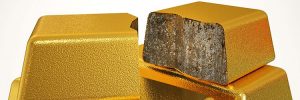 This past week has been interesting for the precious metals markets. When the market seems like it will take off, prices modulate and lay flatter than a pancake. Predictions as what the markets will do are all over the place without a consensus answer from analysts.
This past week has been interesting for the precious metals markets. When the market seems like it will take off, prices modulate and lay flatter than a pancake. Predictions as what the markets will do are all over the place without a consensus answer from analysts.
It reminds me of the quote attributed to President Harry S. Truman, “Give me a one-handed Economist. All my economists say; ‘on one hand…,’ then ‘but on the other….’”
This past week, the Anti-Counterfeiting Educational Foundation (ACEF) weighed in with another problem in this market: COUNTERFEITING!
Counterfeiting is not a new problem. What makes the problem more pronounced is that with much of the country staying home and Internet usage increasing, the number of websites trying to scam people out of money has risen. ACEF has been monitoring the problem and has reported over 100 websites selling counterfeit coins and bullion to government enforcement agencies.
Many of these counterfeiters create slick websites. Not only is it easy to create professional-looking sites with modern tools, but it is easy to copy information from one website to another. Once the scammer has the information they want, it is easy to repurpose it to scam people. They also copy the text from legitimate websites, especially if English is not their first language. It is easier to steal the text than have to create their own.
- If the price is too good to be true, it is probably a scam. Check a site like kitco.com for the current Bid/Sell price. If the offer price is below the current Bid, be wary of the seller.
- Many scammers do not include real information about their location. Beware of the seller if they do not have a physical address. I know that there are exclusively online dealers that work from home but use post office boxes, so they do not publicize their home address. For those dealers, you will have to do more investigations. However, if the dealer is using a private postal box, you may want to avoid their offers. Private postal box services have fewer verification checks than the Post Office. Also, if something happens with a Post Office Box, you will have a stronger case when you complain to the Postal Inspection Service.
- Nearly everything said about addresses can apply to telephone numbers. Telephone numbers can be faked, rerouted, sent to a pay-as-you-go phone that some people call a “burner phone,” and so many more options. The problem also exists for toll-free telephone numbers but with an additional issue: when you call a toll-free telephone number, the owner of the number will get the phone number of the telephone you used to call. Since the recipient is paying for the call, they have the right to know where the call originated.
“But Scott,” you ask. “How do I figure out if this information is real?”
Let your favorite search engine be your friend.
Use your favorite search engine and type the address into the search bar. What information comes up for that address? Is the address a business? A private home? A private mailbox service?
Use an online map service that shows street views, like Google Maps. Search for the address found on the website. What can you learn from looking at the street view?
You can also enter the telephone number as a search term. In many cases, you will find one of the many “is it a scam” websites. These sites rely on users to enter data about their experiences with the telephone number. Click on a few to see what others have said about the telephone number in question.
With those essential tools, you should be able to avoid most scammers. Unfortunately, the professional scammers know their way around these issues. Then again, some of those scammers work out in the open. They run legally but use emotion, patriotic-sounding buzzwords, and extremist rhetoric to convince buyers to overpay for their products.
If you think you have been scammed or there is a question about a dealer, contact the ACEF (www.acefonline.org) and ask for assistance.
Finally, if you are in the market to buy precious metals, you should consider working with a member of the Accredited Precious Metals Dealer program (www.APMDdealers.org).
And now the news…
 → Read more at bloomberg.com
→ Read more at bloomberg.com
 → Read more at newzhook.com
→ Read more at newzhook.com
 → Read more at finance.yahoo.com
→ Read more at finance.yahoo.com
 → Read more at moneyweek.com
→ Read more at moneyweek.com

